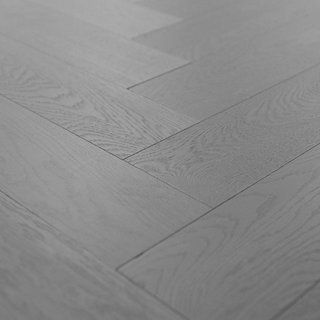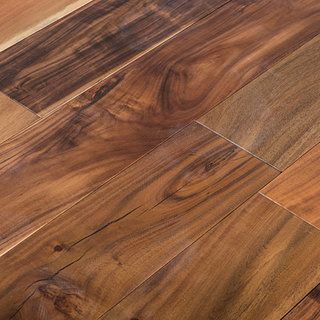
Sale Flooring Direct Blog
Is laminate flooring a choice good for your kitchen?
Posted: 17th July 2020

Laminate flooring has grown in popularity for many reasons. As a more cost effective, durable and versatile alternative to other flooring options. It is perfect for those looking to revamp their home for the fraction of the cost of the hardwood alternative.
More & more homeowners are choosing laminate flooring for their kitchens, because of its many benefits. But what should you know before you buy?
Positives
Price
In comparison to hardwood, laminate flooring and installation costs about half as much overall. Tiles and real wood have been popular over the years, but to transform a room for the fraction of the cost, laminate flooring is your best choice.
Laminate flooring allows you a greater versatility than hard wood as due to the imprinting process, you can have a variety of designs creating a high end look for a budget friendly price.
Durability
When looking at the durability of laminate flooring looking at at AC number is a good starting point. Introduced by the European Producers of Laminate Flooring (EPLF) the AC or Abrasion Class is a measure of how durable different types of laminate flooring are.
The higher the number, the more durable the flooring is with the scale going from AC1, moderate residential which would suit bedrooms, all the way up to AC5, heavy commercial which is suited for the likes of public buildings. AC3 or higher will protect your kitchen against dropped items, pets and sliding tables & chairs.
Most laminate floor is scratch resistant as due to the different layers that make up this pressed wood its central, core layer is protected from any long-lasting damage.
Because of this durability it is therefore very family friendly as it can withstand the scratches and spills. It’s also worth noting that it does not fade in sunlight as quickly as hardwood might.
Maintenance
Laminate flooring is very easy to care for once it has been installed, dust and dirt can simply be brushed away and spills and stains can be removed with a simple mop to leave the floor with a polished finish.
Check out our cleaning hints & tips, should you be struggling with any stubborn stains.
Laminate flooring is also not hard or cold making it a more family friendly choice (especially if your children will be spending a lot of time in the kitchen).
Installation
A main positive for laminate flooring is the simplicity of the installation process, which can be done as a DIY task in comparison to hard wood or tiled flooring.
By simply clicking or gluing the planks together you can lay your floor with ease, transforming it cheaply in short space of time. Check out our guide, if you need a hand with installation.
Versatility
Being a cost effective, durable and easy to maintain alternative to hardwood, laminate flooring is very versatile in the modern home.
Many choose laminate flooring in their kitchen as it is suitable for pets, as well as being hypoallergenic, this is a particular benefit to those of you with open plan kitchen/living spaces.
To top it all off, choosing friendly to your budget, DIY talents and cleaning skills. What more could you want for your money?
Concerns
As with most things in life, where there are pros, there are also cons. However, I am pleased to report that with laminate flooring there are very few and with the right maintenance your floor will remain as good as new!
Moisture damage
As with all surfaces in a household, they will meet with water in some shape or form, this is probably more prevalent in the kitchen. Every flooring has an absorption limit, even ceramic and porcelain tiles as the water can get through the grout.
Laminate flooring in turn is water resistant and not waterproof. Laminate flooring can withstand spills if the moisture is removed in a timely manner. Depending on the volume of moisture that the flooring meets, some water can travel to through the layers, leading to damage it.
To combat this it is vital to ensure that you have tight seams and seals, particularly around the edges of the flooring near the walls, to ensure that there is a tight finish to make sure that water does not reach inside the planks.
Another way to combat this is to install sheet vinyl or luxury vinyl plank (LVP) flooring which is 100% waterproof.
Can be difficult to replace
A laminate floor can’t be refinished unlike hardwood flooring. Once one plank is damaged it will need to be replaced.
Therefore, it is always a good idea to buy some extra planks when laying a new laminate floor. Especially considering that your kitchen tends to be one of the higher traffic areas in the home!
However, if you did not have the hindsight to order some spare planks, then you might be left in a pickle. Due to wear and tear, it might be difficult to find a plank to match the colour and uniformity of the rest of the kitchen.
Although this can be said for hardwood as well, so this is not just limited to laminate flooring itself.
Will my floor look artificial?
One thing that might come to mind when researching flooring options is the overall look it creates. As with many things in life, you get what you pay for and this too applies to laminate flooring.
However here at saleflooringdirect.co.uk there is a real variety of styles and prints available in laminate flooring & you are spoilt for choice, as well as the nice price tag that goes along with it.
We hope that this post has answered any questions you had about installing laminate flooring in your kitchen & addressed more of the pressing concerns that you may have had with it. Leaving you confident in choosing it for your kitchen & open planned living spaces.
However, if you have any other questions or queries, get in touch with one of our experts & they will be delighted to help you out!








